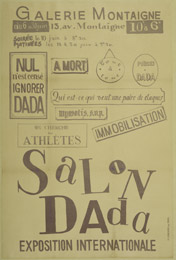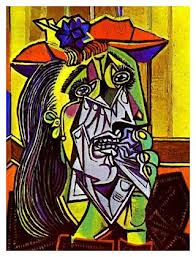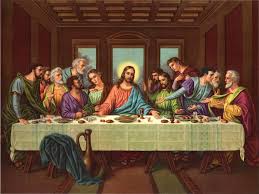Dada was a small artistic and literary movement that appeared in Europe during the middle of the first World War around 1916. The movement its self protested against the horror of WW1 as well as a protest against the upper class who they believed inspired the war. The followers of the movement rejected rules, logic and rational art and embraced the irrational and absurd.
Due to the war a number of the artist, writers and intellectuals found refuge in Zurich (Switzerland being neutral ground) where the art movement was thought to of really started.
One of the main founders of Dadaism was Tristan Tzara a Romanian-born French poet and essayist. Tzara wrote the first Dada texts as well as the movements manifestoes – 1924: Seven Dada Manifestos. While in Pairs he worked with Andre Breton, Philippe Soupault and Louis Aragon to shock the public with there work in Dadaism. In 1929 he move more towards more constructive works in the Surrealism movement.

Poster for Salon Dada – 1921
The Dada movement was a vary male dominated art movement but did have a few female contributors most notably Emmy Hennings. To escape growing nationalism Hennings moved to Zurich in 1915. While in Zurich she worked in a Cabaret where she was the star attraction. She not only performed popular songs from Paris, Berlin and Denmark but also Chinese ballads, folk songs and both her own poems and poetry written by other dadaists.
Twilight Song
for Hugo Ball
Octaves reel, and through the grey years — echoes
as heaps of days collapse upon themselves.
I want only to be yours.
Within my tomb my blond hair grows;
in elderberry bushes live strange folk.
A pale curtain whispers “homicide.”
Two eyes range restless through the room,
inside our cupboards spirits hide.
Little fir trees are the children’s souls
and ancient oaks the souls of aged men
that whisper of miscarried lives.
The cliff-king sings an old, old tune.
I had no guard against the evil eye,
Though black men creep out of the water pail,
The picture book’s Red Riding Hood
Has me in thrall for once and for all time.
A poem by Emmy Hennings
The main element to Dada art was that it was random, depended on chance and cynical. It also reflected life and non-sensical nature of war. One defining element was to be a true Dadaist you had to also be against Dada.
After Dada had died out in Berlin it made small appearances in America and Barcelona but eventually gave way to surrealism roughly around the 1920s. Surrealism used many characteristics from Dada especially in performance with crowds being represented by one person, using a MC to explain or announce each action and purposely provoking the audience.
One of the defining members of surrealism was Andre Breton born 1896. He was know as the fonder of surrealism after being involved with Dadaism for some time with his writings including the first surrealism Manifesto in 1924. He defined surrealism as being ‘pure psychic automatism, by which an attempt is made to express, either verbally, in writing or in any other manner, the true functioning of thought.’
The publishing of the first surrealist manifesto lead to the set up of the Bureau of Surrealist research. The Bureau focus there work towards automatism, dreams, the un conscious, the unexpected, memory and psychological studies. Many of there works were considered ‘dream-like’ and disjointed from reality.

Salvador Dali – Premonition of Civil War 1936

Philippe Halsman – Salvador Dali A (Dali Atomicus) 1941
The end of WW2 generally marked the end of the surrealist movement. During the period of optimism after the war seen movements such as Expressionism/ Abstract Expressionism and Pop Art.

.jpg)


















 One of the biggest features used in Renaissance Art was the use of perspective that had not been widely used in art before as seen above in Da Vinci’s Last supper. This drawing below was done of a local store near me in a perspective style.
One of the biggest features used in Renaissance Art was the use of perspective that had not been widely used in art before as seen above in Da Vinci’s Last supper. This drawing below was done of a local store near me in a perspective style.